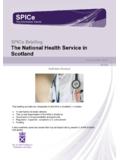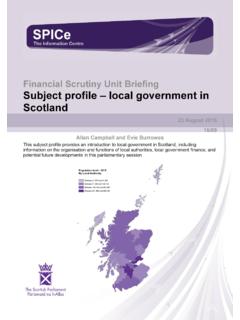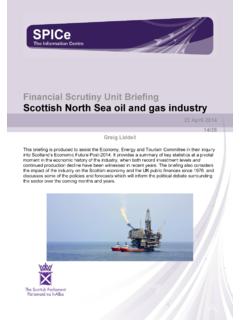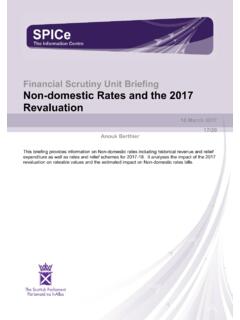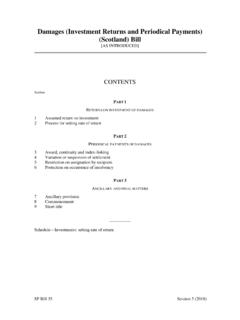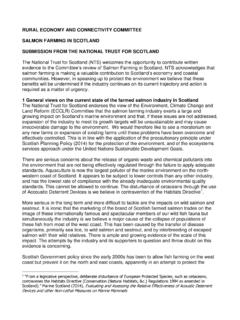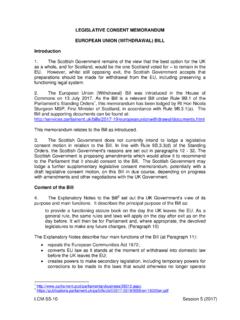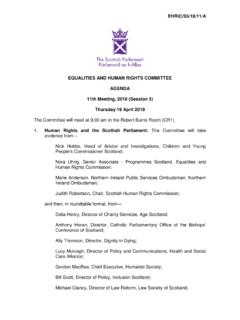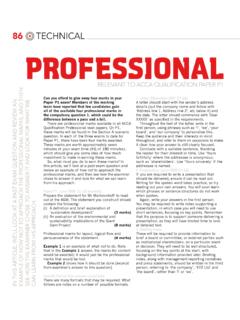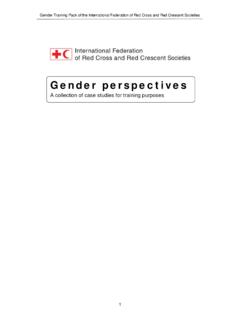Transcription of The European Union Multiannual Financial Framework and ...
1 The Sc ot tish Parliament and Scottis h Parliament I nf or mation C entre l ogos . SPICe briefing European Union Funding in Scotland 2014-2020 7 November 2016 16/89 Iain McIver and Simon Wakefield This briefing , requested by the European and External Relations Committee provides details of the European funding for Scotland during the 2014-2020 programming period. 2 CONTENTS EXECUTIVE SUMMARY .. 3 WHAT IS EU FUNDING AND WHAT IS IT USED FOR? .. 4 HOW MUCH EU FUNDING DOES SCOTLAND RECEIVE? .. 5 WHAT SCOTLAND CONTRIBUTES .. 6 WHAT WILL HAPPEN DURING THE CURRENT FUNDING PROGRAMMES UP UNTIL 2020? .. 7 The UK government guarantee .. 7 What this means for Scottish funding .. 8 After the UK leaves the EU.
2 8 A CLOSER LOOK AT THE KEY PROGRAMMES .. 9 THE COMMON AGRICULTURAL POLICY .. 9 The CAP in Scotland .. 9 Less Favoured Areas Support Scheme .. 10 LEADER .. 11 European MARITIME FISHERIES FUNDING .. 13 THE STRUCTURAL FUNDS .. 14 What are the structural funds and what are they expected to achieve? .. 14 How decisions on funding are made .. 14 Who spends the structural funds? .. 14 What types of project do the structural funds help deliver? .. 16 Which parts of Scotland benefit the most from structural funds? .. 17 How much funding has been committed so far? .. 18 The effect of the falling pound .. 18 COMPETITIVE FUNDING .. 19 Horizon 2020 .. 19 How much Horizon 2020 funding has Scotland secured?
3 19 Which parts of Scotland have taken part in Scottish Horizon 2020 projects .. 19 Types of organisation in receipt of Horizon 2020 funding .. 20 SCOTTISH UNIVERSITIES IN RECEIPT OF HORIZON 2020 FUNDING .. 21 ANNEX - OTHER EU FUNDING PROGRAMMES .. 22 SOURCES .. 28 RELATED BRIEFINGS .. 30 3 EXECUTIVE SUMMARY This briefing provides a picture of the EU funding Scotland is scheduled to receive over the next few years, how it will be spent, and by whom. Between 2014 and 2020, the European Union is expected to distribute up to 960 billion of funding. Prior to the Brexit vote Scotland expected to receive billion over the seven year programme period, the largest portion of this being payments to farmers through the CAP Pillar 1 programme.
4 941 million was also allocated towards support for economic development in Scotland through the structural funds, whilst 478m was allocated towards CAP Pillar 2 (rural development) and 108m to the EMFF (fisheries) fund. EU funds are proportionately more important to Scotland than the rest of the UK. Scotland was set to receive 14% of the UK s funding between 2014 and 2020, compared to its population share (in 2015) of The UK Treasury has made a number of guarantees to enable the continuation of funding in Scotland whilst the UK remains a member of the EU, and in the case of CAP Pillar 1, guarantees that will run until the end of 2020. For the structural funds there are significant sums which have still to be committed.
5 Some 350m has now been committed and a further 450m remains uncommitted, and requires match funding from the Scottish public sector. One challenge for the Scottish Government is to ensure the structural funds are match-funded and legally committed before the UK leaves the EU. The structural funds feed into a complex landscape of support for economic development. EU funding supports a range of public bodies such as Scottish Enterprise and Highlands and Islands Enterprise, local government and some of the work of the Scottish Government itself. Activities funded include skills and training, support to business and the development of infrastructure. Around 63m of Scotland s allocation of EMFF (fisheries) is discretionary and available for eligible projects.
6 Of this, just over million has been committed, leaving around million eligible for further project awards. Scotland also receives funding from the so called competitive funds. These are (usually trans-national) funds that Scottish organisations can bid into, and a list is provided in the annex to this briefing . One prominent example is the 76 billion Horizon 2020 programme, the EU s main programme to support research and innovation. By July 2016, Scottish organisations were participating in projects worth around 250 million. Nearly three quarters of this ( 184m) had been secured by Scottish universities. Assuming the United Kingdom leaves the European Union before the end of 2020, it will not participate in future CAP and structural funding programmes.
7 This will mean that, once the United Kingdom has left the EU, the provision of future Financial support for organisations and projects which previously received EU funding will be a decision for the UK and Scottish Governments. 4 WHAT IS EU FUNDING AND WHAT IS IT USED FOR? The European Union funds Member States through its Multi-annual Financial Framework (MFF). The current MFF runs from 2014 to 2020 and involves a maximum spend across Europe of 960 billion (or 812 billion, at September 2016 exchange rates). The MFF is now a fairly complex piece of Financial machinery, developed over a number of years, to try and take account of different needs of Members of the EU. The MFF is funded by Member States using three calculations: Traditional Own Resources (based on a customs tariff) VAT based calculation Gross National Income based calculation For some Member States (including the UK) there then follows a Financial Correction Mechanism (sometimes referred to as the rebate).
8 The MFF allocates funding to a number of different expenditure headings and sub-headings. In the 2014-20 Framework , over 80% of funding goes to: Competitiveness for growth and jobs Economic, social and territorial cohesion CAP; market related expenditure and direct payments (known as Pillar 1) CAP: rural development (known as Pillar 2) It is also worth noting that there are two broad types of funding: Pre-allocated funds the formula for allocating these funds to the Member States (including the big programmes such as CAP and the Structural funds) is agreed at the outset of the MFF Competitive funds - Scottish projects, or projects involving Scottish stakeholders need to bid for funding against other projects across the European Union .
9 There is no pre-allocated share for Member States. There are many competitive programmes open to Scottish partners. Examples include Horizon 2020 (which supports research and innovation) or Erasmus+ (which supports education, training youth and sport). Further details on competitive funds are provided later in this briefing . Pre-allocated European funds come with a requirement to match fund the grant provided, the major exception being the CAP Pillar 1 programme. Further detail on how the EU is funded and how it spends its money is contained in the SPICe briefing on the Multi-annual Financial Framework (McIver 2016). 5 HOW MUCH EU FUNDING DOES SCOTLAND RECEIVE? Figure 1 below sets out the major areas of pre-allocated European funding that prior to the Brexit vote Scotland was expecting to receive between 2014 and 2020: Figure 1 Pre-allocated European Funding expected for Scotland 2014-20 ( m) (Sources: Scottish Government 2016, UK Government 2016, UK Government 2014, UK Government 2013) In total over the seven years of the programme Scotland expected to receive just over billion from the four pre-allocated funds, with the CAP Pillar 1 payments accounting for the largest proportion of this total.
10 It is not possible to provide a figure for the Competitive funds as they are distributed through a number of competitive funding rounds which take place throughout the seven year programming period. Figure 2 shows how much funding Scotland expected to receive as a percentage of the UK receipts. Scotland expected to receive 8% of the UK s structural funds, and nearly half of the EMFF (fisheries) funds. Figure 2 Scotland s share of the UK 2014-20 funding (Source: Office for National Statistics (2015) 108 478 941 4096 EMFF (fisheries)CAP Pillar 2 Structural FundsCAP Pillar 18% 16% 18% 44% 14% 0%20%40%60%80%100%Structural FundsCAP Pillar 1 CAP Pillar 2 EMFF (fisheries)Total of Pre-allocated funds 6 WHAT SCOTLAND CONTRIBUTES As indicated above, as a member of the EU the UK contributes to the EU budget (and receives funding via a number of programmes).)
